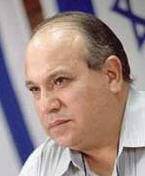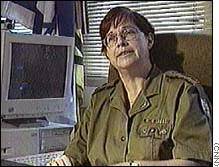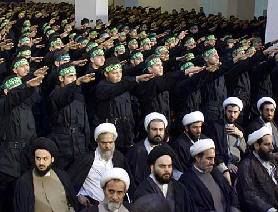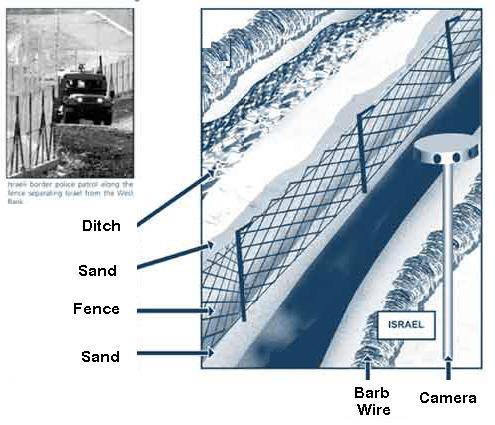hezbollah mossad
 |
According to
Sayed Abdullah,
who operates an intelligence services firm in Indonesia, It is clear that
the CIA and the
Mossad have infiltrated such organizations [Jemaah
Islamiyah,
Hamas,
and Hezbollah].
Abdullah told
Kazi
Mahmood
of IslamOnline
the he believe it is obvious the CIA and the
Mossad,
assisted by the Australian Special Action Police (SAP) and the M15 of
England, are all working towards undermining Muslim organizations in an
attempt to weaken the Muslims globally.
|
Abdullah
believes the Bali
bombing of 2002
was an operation clearly financed and assisted by the CIA and
Mossad,
made use of Muslims to carry out the final act
. Those Muslims were not
innocent since they took the bait handed over by the CIA and the
Mossad
to bomb Bali and to avenge against the U.S. war on the Muslims in
Afghanistan.
|
Brothers & Sisters, Saddam Hussien was a brutal
dictator, who never tolerated decent. However, you have to give the devil his
dues. He never allowed the religious fanatic to bomb each others!!!. Our
gravest mistake was removing him. Now, we are stuck with the fanatics.
Israeli Mossad infiltrated the
religious extremists and they are having them
bomb each other!!!. Unfortunately, the extremists are stupid to realize it. I
apologize for using the word (Stupid) but it is an accurate discription of
people whose emotions totally dominate their logic. I PRAY FOR COMMON SENSE &
WISDOM, Frank (Peacemaker) USA
|

|
Mossad has such an effective
Intelligence operation inside the Moslem world because the Moslems do not
know to whom they are providing the information which Mossad obtains by
its penetrations of Moslem countries and their Intelligence organs. Recent
Mossad Intell gave precise locations for Nasrullah's whereabouts and he
was targettted...he is injured and the reason he was accurately targetted
is that
Mossad has penetrated and
infiltrated the upper levels of Hizbollah.
|
|

|
According to the officials, the
building itself was completely destroyed and the IDF was checking the
results of the strike β whether the senior Hizbullah officials Israel
was targeting were actually at the scene.
ADDITIONALLY, a senior
IDF
officer said that
Israeli
intelligence had significantly infiltrated Hizbullah.
(Hanan Greenberg)
(07.20.06, 00:41)
|
|

|
Wheeler
was also suspicious that the UASR's current head, Ahmed Yousef, had
ties to Hamas.
Yousef gave an interview to a Middle Eastern magazine in which he claimed
that 9-11 was a
Jewish plot:
"No one could have captured the pictures [of the 9-11 attacks] so
perfectly except for the cameras in the hands of several
Mossad
agents, who
were near the scene of events and succeeded in filming the scene so that
it will always serve Zionism to remind the world of the Arabs' and
Muslims' crimes against America." Why would
Mossad
do this?
|
As Yousef
explained, Mossad
had "a grand scheme
and right-wing forces may have participated in it, and evangelical
Christians agreed to it. All of them agreed that this scheme should be
carried out in this way to
push America into war."
U.S.
authorities have no doubt there are terrorist sleeper cells in our midst.
In 2002 the FBI concluded in an internal review that somewhere between 50
and 100 Hamas and
Hezbollah operatives had infiltrated
into America. The FBI believed these operatives "were in America working
on fund-raising and logistics, and they had received terrorist and
military training from Lebanon and other countries in the Middle East,
giving Hamas and
Hezbollah
the capability of launching
terrorist strikes."
|
How could Iran supply Hezbollah
right under the nose of Lebanese government?
I an sure Lebanon is
crawling with Mossad
scum right after Syrians left, both must be cooperating
nicely with country officials. That's how it works, on power leaves, another
power will immediately fill the vacuum.
Who Funds Hezbollah
|

|
Membership to this club requires an unfathomable capacity for evil. The
president of Iran has repeatedly denied the Holocaust, while gleefully
preparing the next one. Many of the long-range missiles fired into
Israel
in recent days were Iranian missiles, made by the same regime that is now
trying to possess nuclear weapons - this same regime that is
funding Hezbollah to the sum of 100 million dollars a year.
|
| |
|
| |
|
| fence |
|
 |
In
the past,
Israel
has been willing to move fences, even elaborate and expensive ones
such as this security barrier.
Along the border with
Lebanon,
where a high-tech fence equipped with surveillance cameras and sensors
closely monitors the situation,
Israel
has moved sections of
fence
more than a dozen times in order to implement its
U.N.-certified withdrawal
from
Lebanon.
|
Israel
has maintained that the security
fence
will be an obstacle to terrorism, but not to an agreement with the
Palestinians. I do not believe that the routing of the
fence
can prevent a real accord, said Finance Minister
Benjamin
Netanyahu.
A
fence
can always be moved.
|
| links |
|
IDF retrieves bodies of four tank soldiers killed in
south Lebanon ![]() By
Amos Harel
and Jack
Khoury, Haaretz Correspondents
By
Amos Harel
and Jack
Khoury, Haaretz Correspondents
![]() Israel Defense Forces
soldiers managed Thursday to retrieve the bodies of four
comrades killed a day earlier when
their tank was destroyed by a mine in south Lebanon.
Israel Defense Forces
soldiers managed Thursday to retrieve the bodies of four
comrades killed a day earlier when
their tank was destroyed by a mine in south Lebanon.
Efforts to retrieve the victims, which were ongoing since Wednesday, were
carried out under heavy Hezbollah gunfire.
The IDF placed a tight security ring around the tank in order to prevent
Hezbollah fighters from reaching it.
The Merkava-2 tank was destroyed by a
mine packed with between 200 and 300 kilometers of explosives.
The incident took place when IDF infantry and armored
forces entered Lebanon after a Hezbollah cross-border attack and the
kidnapping of two soldiers.
Hezbollah seeks to transfer soldiers to Iran
Israel has concrete evidence that Hezbollah plans to transfer the two Israel
Defense Forces soldiers abducted Wednesday to Iran, Foreign Ministry spokesman
Mark Regev said Thursday.
"We have concrete evidence that
Hezbollah plans to transfer the
kidnapped soldiers to Iran. As a result, Israel
views Hamas, Hezbollah, Syria and Iran as the main players in the axis of
terror and hate that endangers not only Israel, but the entire world," AFP
quoted Deputy Director General of the Foreign Ministry Gideon Meir as saying.
An Al-Jazeera correspondent said Thursday that he had evidence that the two
soldiers - identified Thursday as Ehud Goldwasser, 31, of Nahariya, and Eldad
Regev, 26, of Kiryat Motzkin - were alive during the abduction. He said they
were transferred to a Shi'ite mosque in a nearby town, where the abductors
changed clothes. According to the report, one of the soldiers was transferred
in a cab, to make it difficult for Israeli intelligence to locate him. The Al-Jazeera
correspondent stressed that he had received the information from a source
close to Hezbollah, and that members of the organization refuse to disclose
more information with nothing in return.
Incident
|
 |
Eight IDF soldiers were also
killed in a series of Hezbollah assaults on the northern border Wednesday.
Another five soldiers and five civilians were wounded in the attacks.
Israel responded with massive aerial attacks on targets throughout Lebanon.
The fighting began at about 9:00 A.M., when a group of reserve soldiers in
two armored jeeps was
conducting a routine patrol of the border. As the jeeps passed between Moshav
Zarit and Moshav Shtula, Hezbollah attacked.
|
An initial inquiry revealed that the Hezbollah operatives had crossed the
border earlier via a "dead zone" in the border fence not visible from any of
the IDF observation posts. There are dozens of similar "dead zones" along the
northern border, though the IDF said that observation cameras to cover this
particular spot were due to be installed next week. The assailants may have
used a wheeled ladder to climb
over the fence.
The operatives hid themselves
in an overgrown wadi about 200 meters on the Israeli side of the fence and
waited until the IDF troops arrived, whereupon they attacked, apparently with
a combination of explosives and anti-tank missiles.
|
Three soldiers were killed during the initial assault, while one soldier was
seriously wounded, another lightly wounded and a third suffered a shrapnel
scratch. In addition, the
assailants kidnapped the two soldiers. According
to the IDF, Hezbollah probably had an escape vehicle waiting on the other side
of the fence. The entire incident took no more than 10 minutes, and the
Israeli soldiers apparently never fired a shot.
Ambush and diversionary attack
Simultaneously with this ambush, Hezbollah also launched a diversionary
attack: a barrage of mortar shells and Katyusha rockets on communities and IDF
outposts in the western part of the border area. That assault wounded five
civilians, though none seriously: Some were lightly wounded, and the others
suffered from shock.
As soon as this barrage began, the Galilee Division conducted a routine check
to ensure that all army outposts and vehicles were still in contact with
headquarters, and quickly discovered that contact had been lost with the two
jeeps patrolling near Zarit. Both jeeps had been damaged in the Hezbollah
assault. A rescue force was summoned to the scene, and when it arrived, about
half an hour after the attack, it found the two damaged jeeps and the dead and
wounded soldiers. The rescue force soon realized that two of the soldiers had
been kidnapped and sent out an alert.
Due in part to the lessons learned from the abduction of Corporal Gilad Shalit
less than three weeks earlier, a
force of tanks and armored personnel carriers was immediately sent into
Lebanon in hot pursuit. It was during this pursuit, at about 11:00 A.M., that
the second deadly incident occurred: A Merkava tank drove over a powerful
bomb, containing an estimated 200 to 300 kilograms of explosives, about 70
meters north of the border fence. The tank was almost completely destroyed,
and all four crew members were killed instantly.
Over the next several hours, IDF soldiers waged a fierce fight against
Hezbollah gunmen as the soldiers tried to extricate the damaged tank, in order
to recover the bodies and to keep Hezbollah from stealing it. During the
course of this battle, at about 3:00 P.M., another soldier was killed and two
were lightly wounded. As of press time Wednesday night, however, the tank had
still not been extracted.
Due to the force of the bomb, only bits and pieces of the soldiers' bodies are
likely to be found inside.
The damaged tank did not have armored plating on its belly; most tanks with
such protection are stationed on the Gaza border. However, tank officers said
that due to the size of the bomb, such plating would still not have saved the
soldiers' lives.
The fighting continued throughout the day, with
Hezbollah gunmen repeatedly trying to
attack army outposts along the border. At the
Oranit outpost near Rosh Hanikra, soldiers killed one Hezbollah operative;
other Hezbollah gunmen were apparently killed during an assault on the
Dvoranit outpost. The IDF suffered no casualties during these battles.
In response to the Hezbollah onslaught, the IDF attacked dozens of targets
throughout Lebanon, including Hezbollah outposts and several bridges over the
Awali River. According to the IDF, all Hezbollah outposts along the border
were destroyed. The bombing, which included targets in central and northern
Lebanon, apparently caused multiple Lebanese casualties.
According to GOC Northern Command Udi Adam, the IDF had no intelligence
warnings of the Hezbollah attack. After Shalit was kidnapped, he said, the
army decided to up the alert level in the north for fear of a similar attack,
but a few days ago, the alert was lowered again.
Schools
Hezbollah is an Islamic resistance group and political party based in Lebanon.
Founded by Shia Muslims to resist Israel's invasion of Lebanon in 1982, the
group's political and military success has made it a model for other Islamic
movements worldwide.
History
Hezbollah was
founded in the early 1980s by Lebanese
Shia who wanted to fight the Israeli army,
which since 1982 had occupied a large area of southern Lebanon.
The movement grew quickly after
receiving Syrian and Iranian logistical, financial and military support. Its
members carried out numerous suicide attacks against Israeli targets inside
Lebanon.
By the late 1990s
Hezbollah
had developed into a sophisticated political party while also funding free
schools, hospitals and social programmes
for Lebanon's often impoverished and rural Shia population.
TV channel
The group has gained in popularity in southern Lebanon,
running schools and hospitals and
even a satellite TV channel.
Hezbollah gets most of its arms through Syria, where it
has a headquarters, and the group freely admits it gets much of its funding from
Iran. Diplomatic sources say the funding includes
$20 million to $40 million a month.
But at the same time, its
fighters continued to mount ever more lethal attacks on Israeli forces in
Lebanon, leading to an increasing pressure on the Israeli government to pull
out.
Israeli defeat
In May 2000 Israel withdrew from
all of Lebanon. Hezbollah was widely seen as the cause of the Israeli defeat.
Many observers hailed the group as the first Arab military force to defeat an
Israeli army.
But while the group's popularity
soared within Lebanon even among many Lebanese Christians and Sunnis - world
powers called for Hezbollah to lay down its arms and enter mainstream politics.
By late 2000 the group was under
increasing international pressure to disarm now that the Israelis had left.
A new role
A few months after the Israeli
withdrawal from Lebanon, the
second Palestinian intifada broke out in
October 2000.
The
violence offered Hezbollah's armed wing a new role and purpose. Within months
the Shia group had rebranded itself as a defender of all Arabs and Muslims
In October 2000 Hezbollah
kidnapped three Israeli soldiers on the Lebanese border and demanded the release
of Arab prisoners held by Israel.
In January 2004 Israel released
nearly 500 Palestinian and Lebanese prisoners in return for a kidnapped Israeli
businessman and the bodies of the four soldiers.
Since the Israeli withdrawal,
Hezbollah has also attacked the Shebaa Farms, an Israeli-occupied area of land
bordering Southern Lebanon. Hezbollah claims that this 25 square km area is
historically Lebanese but the UN and Israel say it was captured from Syria
during the 1973 Arab-Israeli war.
The future
Hezbollah's leader, Hassan Nasrallah, has tried to build the group into the
dominant political party among the Lebanese Shia, who are the largest of
Lebanon's 19 religious minorities.
The movement's success at driving Israel out of Lebanon has inspired many
other Islamic groups around the Middle East from Hamas in Palestine to Muqtada
al-Sadr's Madhi Army in Iraq.
However, Hezbollah remains
dependent on Syria and Iran for funds and arms. The US has frequently called on
both countries to stop supporting the group which is today estimated to have
several thousand fighters.
Syria has previously offered to
disarm Hezbollah if Israel returns the Golan Heights, which it has held since
1967.






